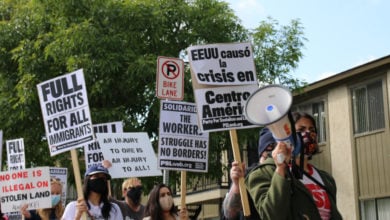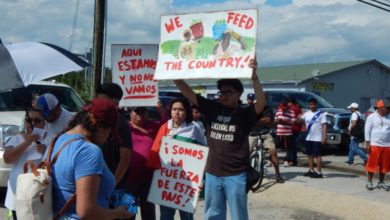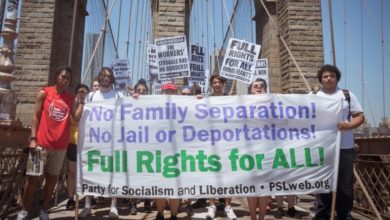 Former braceros in Mexico are fighting to win back millions of dollars they are owed. Photo: Ian Thompson |
Bush explained in earlier interviews, “I’m passionate on [immigration reform] because the nature of this country is one that is good-hearted and compassionate. … The [immigration] system we have today is not a compassionate system. It’s not working.”
His “compassionate” proposal is to expand the country’s temporary guest worker program to include undocumented immigrants.
The historical record of “guest worker” programs shows that the main beneficiaries are rich business owners, not immigrant workers. The last large-scale guest worker program implemented in the U.S. was the Bracero program. Initiated in 1942, it lasted until 1964, by which time the program’s federal director, Lee G. Williams, deemed it “nothing short of legalized slavery.”
The Bracero program
In 1942, many U.S. citizens working in agriculture were either drafted into World War II or sent to factories to help with military production. U.S. agribusiness faced a labor shortage crisis and called on the government for help. The U.S and Mexican governments quickly instituted the Bracero program—bracero means “hired hand”—that brought in Mexican laborers for seasonal harvests or a set period of time. After their contracts expired, most of the workers were deported to Mexico.
As part of the deal, the U.S. government promised to protect the equal rights of the Mexican workers. But in practice, the program became notorious for its brutal exploitation, mandatory overtime, rock-bottom wages, horrible living conditions and corruption.
Although briefly suspended in 1946, aggressive lobbying by agribusiness had the program reauthorized. In 1956, the peak year of the second program, 450,000 braceros entered the country. One quarter of all agricultural workers were braceros. Over 4 million braceros ultimately entered the U.S. as part of the program. The Bracero program came to an end because of significant advances in mechanized agriculture.
The braceros were cheated out of hundreds of millions of dollars in unpaid labor. After a long, organized struggle, survivors have recently won some of this money back. The Mexican government just announced a program to compensate former braceros and their families. Mexico’s program falls far short of what the braceros are actually owed. The U.S. government has offered nothing.
Undocumented workers won’t benefit
The new proposed guest worker program is nearly a repeat of the Bracero program. Most of the guest workers, like the majority of undocumented immigrants in the U.S., come from Mexico.
This time, the program is meant to expand far beyond agriculture. Employment and deportation will not be based on seasonal harvests. According to the White House website, “The program will require the return of temporary workers to their home country after their period of work has concluded. The legal status granted by this program would last three years, be renewable, and have an end.”
Guest workers can only be hired when “no American worker is available and willing to take a job.” As with the Bracero program, U.S. employers will function as the sponsors for immigrants.
Although the Republican Party is divided on the issue—with its overtly racist sectors blasting the program as a disguise for amnesty—Bush has emphasized his opposition to full amnesty for immigrants. His website states: “The program should not connect participation to a green card or citizenship. However, it should not preclude a participant from obtaining green card status through the existing process. It should not permit undocumented workers to gain an advantage over those who have followed the rules.”
An estimated 8 to 12 million undocumented workers live in the U.S. They have struggled for and, at times, won rights that U.S. citizens take for granted: public education, drivers’ licenses, etc. But since they don’t have citizenship, they are criminalized, dehumanized and called “illegal.” The few rights that they have are constantly in jeopardy.
Undocumented immigrants are forced to live in constant fear of deportation. Many are scared to go to the hospital when they are sick, call 911 when there is a fire or voice grievances about unfair working conditions.
Bush advertises his administration’s proposal as a reprieve from these insecurities. He says undocumented workers can “come out of hiding” and embrace the program. But that is mere propaganda. Rather than alleviating the plight of undocumented immigrants already in the U.S., it will create more problems for them.
What Bush’s proposal really means
According to Bush’s program, the legal status of guest workers is contingent upon their employment.
Employers can simply deport laborers if they voice a grievance, refuse an extended workday, or demand better working conditions. As in the past, this sort of system allows bosses to communicate with each other about workers who demand improved conditions, creating a “black list” as they did during the Bracero program.
Bosses could prevent immigrants from gaining full citizenship simply by refusing to rehire them at the end of their contracts. Workers could be immediately deported when their temporary work visas expire. If no employers renew their visas, they would be deported after only three years. Since the temporary status helps bosses keep workers from organizing, there is a clear incentive not to allow immigrants to gain full citizenship by extending their contracts.
Under the existing process, employment-based immigration is limited to 140,000 visas per year. It would take decades for so many undocumented workers to go through the citizenship process.
In reality, the program is not about citizenship at all. It is really an intervention by the government on behalf of the bosses to regulate and manage the flow of cheap labor.
When immigrants’ temporary visas expire or are cut short by employers, many immigrants will avoid returning to the starving economies that they originally fled. They again will be deemed “illegal.” The U.S. government, however, will have their names and addresses on file. It will become much easier to deport them at will.
Unfree labor shackles all workers
In the U.S. capitalist system, free trade—the free flow of capital across borders—is considered a sacrosanct right, whereas laborers who cross borders are criminalized. But making people “illegal” is the real crime. Immigrant workers deserve full amnesty and all the rights entitled to citizens.
Foreign-born workers have always been participants and contributors to the U.S. economy and culture.
Few politicians would mention it now, but as late as the 1920s, non-citizens could vote in many states—as long as they were white. U.S. agribusiness rose to prominence in large part due to the Bracero program. The present-day economy thrives due to the employment of cheap labor both at home and abroad.
The new proposed guest worker program is a way to institutionalize and expand the availability of cheap labor. Employers all over the country—not just in agricultural states where undocumented workers can still be hired rather easily—are licking their chops. An expanded guest worker program will enable the bosses to bring in immigrants with no real labor rights or legal protection, and then send them back with ease.
Bush is proposing the creation of a caste of unfree laborers, similar to indentured servants or even slaves. The failure to provide immigrant workers with the full rights of citizens ultimately will hurt all workers in the U.S. Living conditions will worsen.
The formation of a lower caste of workers will not only create disastrous economic conditions for workers, it will also foster racism and xenophobia. With the encouragement of the bosses and the politicians, many workers who are laid off or underpaid will point their fingers at the immigrant workforce as the source of the problem.
But the capitalist government and the bosses are truly the ones to blame. Workers of all nationalities, genders and sexual orientations share common interests and goals—to win better wages and working conditions. By uniting on a class basis against the ruling class—not only pointing fingers, but also shaking fists—we have a chance to advance together.






